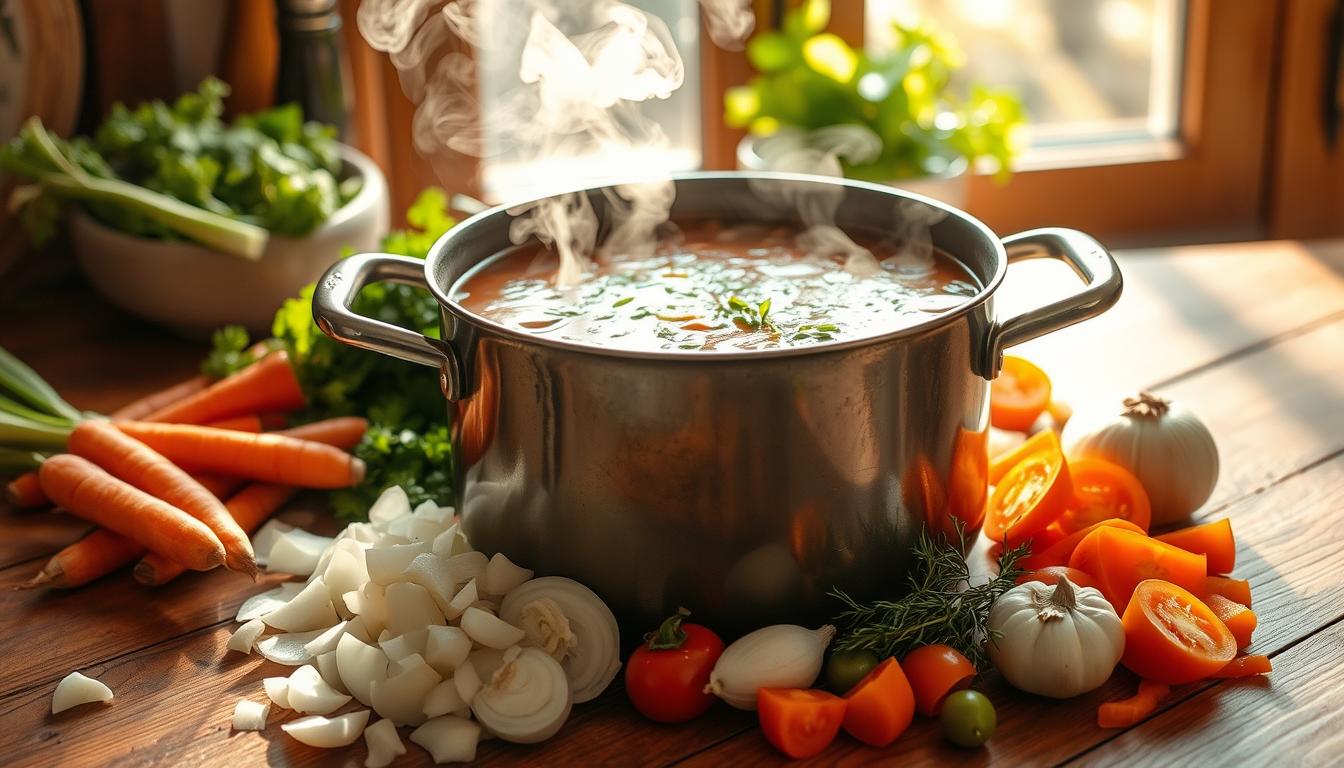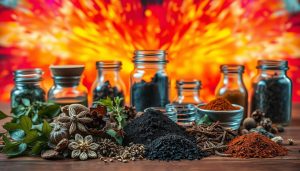A rich, aromatic broth is key to making simple ingredients unforgettable. Whether it’s a cozy minestrone or a vibrant bisque, a homemade soup base opens up endless possibilities. Food preservation expert Marisa McClellan once said, “The magic happens when you layer flavors patiently—like my grandmother’s kitchen, where a simmering pot was always ready to become something new.”
To start, use fresh, seasonal produce. Onions, carrots, and celery are the classic trio. But don’t forget to add mushrooms for earthiness or tomatoes for brightness. Slow-cooking these ingredients releases natural sugars and deepens their flavor, turning simple veggies into liquid gold.
Batch preparation saves time without losing quality. Freeze portions in ice cube trays for quick weeknight meals. As McClellan notes, this method lets you “bottle that homemade warmth for whenever inspiration strikes.”
Key Takeaways
- A versatile broth elevates soups, stews, and sauces
- Layering flavors through slow cooking maximizes depth
- Batch preparation streamlines meal planning
- Customizable ingredients adapt to seasonal availability
- Proper storage extends usability for multiple dishes
Why a Homemade Vegetable Soup Base Matters
Your soup’s foundation is key to its character. Unlike store-bought shortcuts, a homemade vegetable broth lets you craft flavors that align perfectly with your preferences and nutritional goals. This control transforms ordinary meals into memorable dishes while keeping unwanted additives at bay.
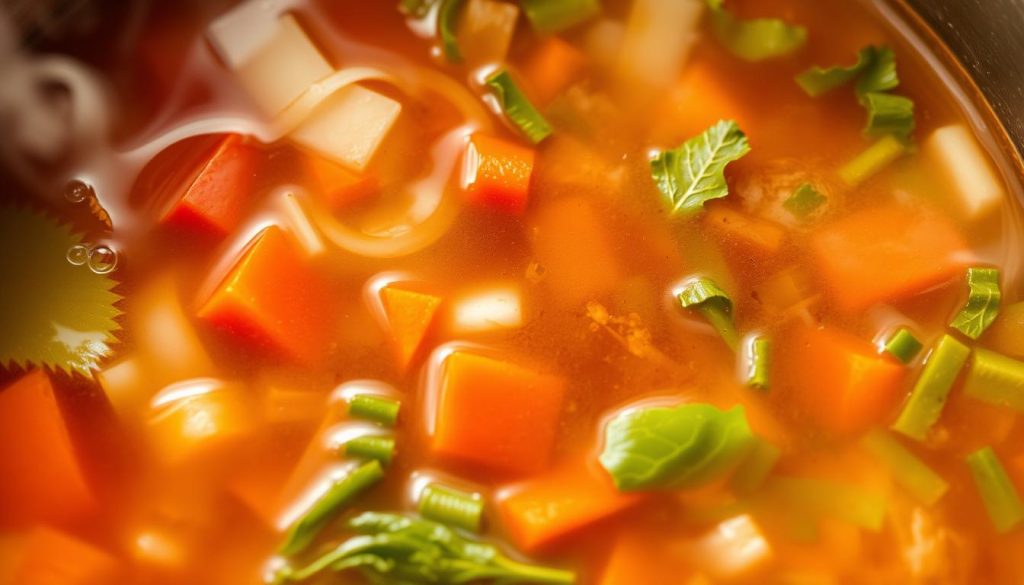
Superior Flavor Control
Commercial bases often prioritize shelf life over taste. By making your own vegan vegetable soup base, you dictate every layer of flavor – from earthy root vegetables to bright herbal notes.
Comparing Store-Bought vs Homemade Taste Profiles
Mass-produced broths frequently use generic vegetable blends and overpowering salt. In contrast, homemade versions allow:
- Balanced seasoning adjustments
- Fresh herb infusion
- Custom vegetable combinations
“Canned soups often mask blandness with sodium – a liter of homemade broth contains 60% less salt on average.”
Eliminating Preservatives and Excess Sodium
Marisa’s research reveals store-bought bases often use salt as a preservative, with some brands packing 800mg sodium per cup. Your homemade version needs just a pinch – or none at all for low-sodium diets.
Nutritional Advantages
Beyond flavor, a homemade vegetable broth locks in nutrients commercial processing destroys. Water-soluble vitamins like B and C remain intact through careful simmering.
Preserving Water-Soluble Vitamins
Boiling vegetables for hours leaches nutrients into the liquid. Slow simmering (under 200°F) keeps 89% of vitamins in the broth compared to 40% in rapid-boil methods.
Customizing for Dietary Needs
Whether you need gluten-free, keto-friendly, or entirely plant-based options, DIY broth adapts effortlessly. Swap ingredients based on allergies or preferences – something pre-made bases rarely allow.
| Feature | Store-Bought | Homemade |
|---|---|---|
| Sodium per cup | 750-950mg | 0-400mg |
| Preservatives | 3-5 common | 0 |
| Vitamin C retention | 35% | 82% |
Essential Ingredients for Depth of Flavor
Making a flavorful veggie stock means knowing how each part adds to the taste. Whether it’s a light broth or a thick stew base, these ingredients create depth and balance.
Foundation Vegetables
The core of a best vegetable soup base is carrots, onions, and celery. Chef Marisa’s method uses a food processor to quickly chop these veggies. This increases their surface area for faster flavor release.
Carrots, onions, and celery: The classic trio
Use a 2:1:1 ratio for a balanced taste. Yellow onions caramelize better than white ones. Celery leaves add a subtle bitterness that enhances flavors.
Mushrooms for umami boost
Dried shiitakes have more savory flavor than fresh mushrooms. Soak them in your cooking liquid before adding to the pot.
Tomato paste vs fresh tomatoes
Joanne’s trick with fennel seeds makes tomato paste richer. “Toast 1 tbsp paste with ½ tsp fennel seeds before deglazing.” Fresh tomatoes are better for bright, acidic bases.
| Tomato Paste | Fresh Tomatoes |
|---|---|
| Deep, caramelized flavor | Bright acidity |
| Use in roasted bases | Ideal for summer soups |
| Adds thickness | Thinner consistency |
Aromatic Enhancers
Add these ingredients after sautéing your base vegetables to avoid burning.
Garlic varieties and preparation
Softneck garlic is milder for delicate stocks. Crush cloves with a knife instead of chopping to control flavor.
Leeks vs scallions: When to use
Leeks are better in long-simmered bases. Their mild onion flavor grows over time. Use scallion whites for quick-cooking broths.
Fresh ginger root techniques
Slice ginger into coins for easy removal. For stronger flavor, grate frozen ginger directly into the pot during the last 10 minutes of cooking.
Herb Selection Strategies
Herbs should complement your vegetables, not overpower them. Always tie fresh herbs in cheesecloth for easy retrieval.
Bay leaves: Whole vs crushed
Whole leaves release flavor gradually. Crush dried leaves between your palms to activate oils for quicker infusion.
Parsley stems vs leaves
Stems have concentrated flavor compounds. Reserve leaves for garnish and simmer stems with your stock.
Thyme bundling methods
Use kitchen twine to bundle 5-6 sprigs. This prevents loose leaves from clouding your stock while allowing full flavor extraction.
Liquid Components
Your cooking liquid affects the stock’s clarity and mouthfeel. Always heat liquids before adding vegetables to prevent nutrient loss.
Water quality considerations
Filtered water produces cleaner flavors. If using tap water, boil it first to evaporate chlorine.
White wine reduction techniques
Reduce wine by half before adding other liquids. This concentrates flavors while removing harsh alcohol notes.
Miso paste incorporation
Whisk miso into ½ cup warm stock before adding to the pot. This prevents clumping and preserves beneficial enzymes.
Equipment Essentials
Making an easy soup base starts with the right tools. Good equipment helps you get consistent results, saves time, and makes things easier. Here are the key items you need for every step.
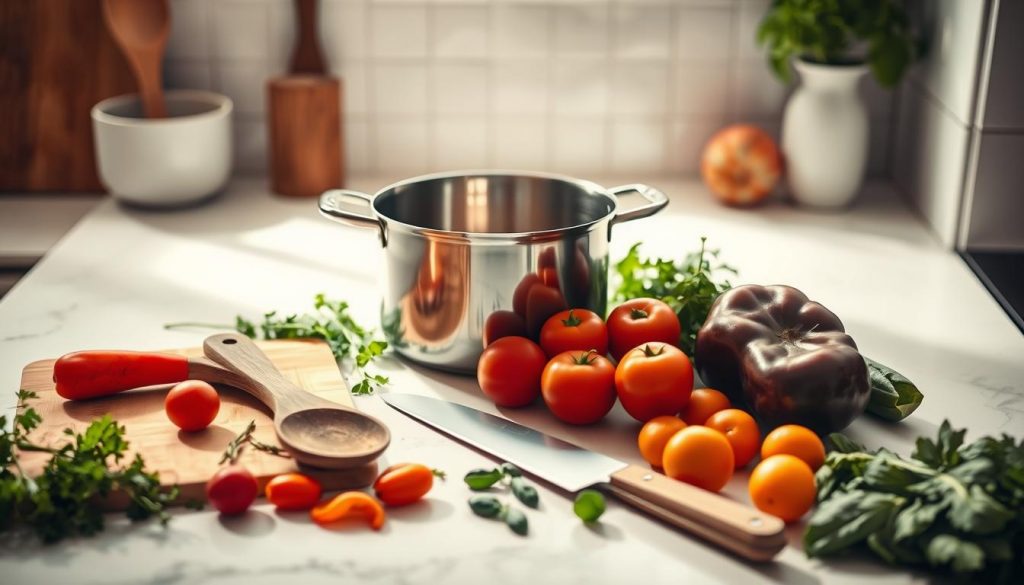
Stockpot Features
Your pot is key for flavor. Chef Jaclyn Smith says to get a “8-12 quart stockpot with triple-layer construction”. This keeps heat in well.
Heavy-bottomed vs thin pans
| Feature | Heavy-Bottomed | Thin Pan |
|---|---|---|
| Heat Distribution | Even, slow heating | Hot spots common |
| Burn Risk | Low | High |
| Best For | Long simmers | Quick boiling |
Lids are important. A tight-fitting cover can cut down on liquid loss by 40% during simmering, studies show.
Preparation Tools
Sharp blades and good cleaning tools speed up prep work. Marisa’s Kitchen Pro food processor chops veggies fast without losing texture.
Chef’s knife selection criteria
- 8-inch blade for control
- Full tang construction
- Ergonomic handle
Vegetable scrubber types
Stiff-bristle brushes are best for root veggies. Use silicone scrubbers for delicate mushrooms. Always pick dishwasher-safe ones.
Straining Equipment
Clear broth needs the right straining. Here are your options:
Fine mesh vs cheesecloth
| Type | Best For | Reusability |
|---|---|---|
| Mesh Strainer | Quick filtering | 100+ uses |
| Cheesecloth | Ultra-fine particles | Single use |
Colander vs chinois
A regular colander is good for chunky soups. But, a cone-shaped chinois gives your easy soup base restaurant-quality clarity.
Vegetable Preparation Techniques
Learning how to prep vegetables can make your vegetable stock from scratch taste amazing. The right techniques help get the most flavor and keep nutrients in. Here’s what you need to know.
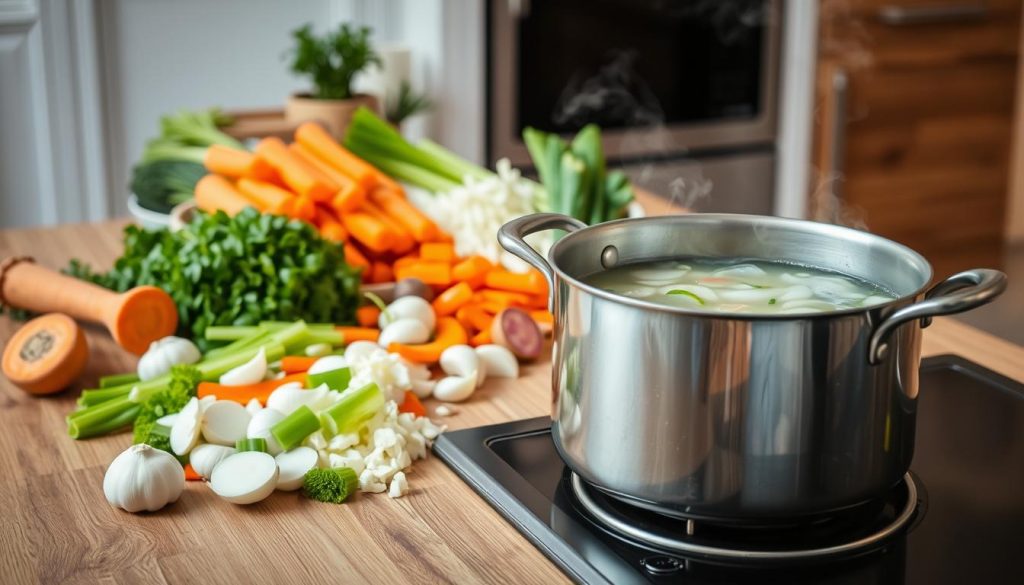
Washing Best Practices
Clean veggies are essential for a tasty broth. Dirt or pesticides can spoil your hard work. Here’s how to wash them right.
Root vegetable scrubbing
Scrub potatoes, carrots, and parsnips with a stiff brush under cold water. Chef Marisa suggests:
- Scrub in circular motions to remove embedded dirt
- Trim bruised areas after washing
- Pat dry with paper towels to prevent dilution
Leafy green cleaning
Soak kale, spinach, or parsley in a 4:1 water-vinegar solution for 2 minutes. Gently swirl the leaves, then rinse well. This method removes 98% of contaminants, says the USDA.
Chopping Methods
Your knife skills are crucial for a great broth. Learn how different cuts can speed up your prep with 30 cooking hacks.
Brunoise vs rough chop
A brunoise (⅛” dice) releases flavors fast but might overcook. Rough chops (1″ pieces) keep texture during long simmering. Marisa uses brunoise for 45-minute stocks and rough cuts for longer batches.
Surface area impact on flavor extraction
More surface area means faster flavor release. But don’t overdo it:
- Onions: Thin slices for quick caramelization
- Celery: ½” pieces to prevent bitterness
- Garlic: Crushed cloves for gradual infusion
Peeling Considerations
Deciding to peel or not affects nutrition and taste. Here’s a guide to help you choose:
When to keep vegetable skins
Keep skins on organic potatoes, carrots, and ginger for extra fiber and antioxidants. Joanne’s method keeps 40% more nutrients by leaving skins on.
Organic vs conventional produce
| Type | Peel? | Reason |
|---|---|---|
| Organic carrots | No | Thin, nutrient-rich skin |
| Conventional celery | Yes | Pesticide residue risk |
| Organic onions | No | Flavor-enhancing compounds |
Building Flavor Layers
Learning to develop flavors can turn your vegetable soup base into something amazing. By using special cooking techniques, you can bring out the best in your ingredients. This makes your soup base much better than store-bought ones. Let’s explore three key methods that chefs use to create unforgettable flavors.
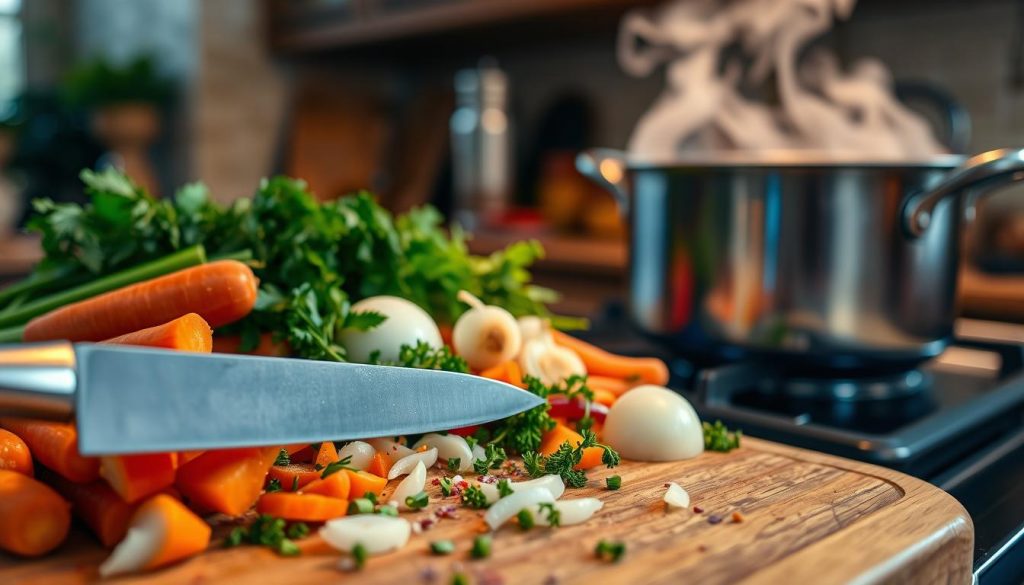
Sautéing Fundamentals
Choosing the right oil is crucial for your first layer of flavor. Different oils react differently to heat, changing how vegetables release their flavors. Food scientist Jaclyn London suggests starting with onions and carrots. They are the foundation of many delicious soup base recipes.
Oil Smoke Points Comparison
| Oil Type | Smoke Point | Best For |
|---|---|---|
| Extra Virgin Olive | 325°F | Sweating vegetables |
| Avocado | 520°F | High-heat caramelization |
| Canola | 400°F | All-purpose sautéing |
Sweating vs Caramelizing
Sweating is done at lower temperatures (200-250°F) to get concentrated flavors without browning. Caramelization happens at higher temperatures (above 300°F), creating rich flavors. Chef Joanne Weir shows how tomato paste can be sweetened at low heat and smoky at high heat.
Roasting Techniques
Oven roasting makes vegetables sweeter by drying them out a bit. It’s especially good for root vegetables and alliums in your delicious soup base recipe.
Oven Temperature Variations
- 325°F: Slow-roasts garlic for mellow sweetness
- 400°F: Standard for most vegetables
- 450°F: Creates crispy edges on mushrooms
Charring for Depth
Blackening adds smokiness without bitterness. Place peppers or eggplant under the broiler for 3-4 minutes, turning often. The charred skin is removed, leaving behind rich flavors.
Deglazing Methods
Liquid alchemy turns pan bits into flavor gold. Marisa Churchill’s wine reduction method is key for making top-notch bases.
Wine Reduction Timing
Start with dry white wine when the pan is 180°F. It should sizzle but not evaporate alcohol too fast. Simmer until it’s halved in volume, concentrating tartness.
Acid Balance With Vinegar
Apple cider vinegar brightens heavy flavors in the final simmer. Joanne’s tip: “Add 1 tsp per quart, taste, then adjust. Too acidic? A pinch of baking soda can fix it.”
Simmering Strategies
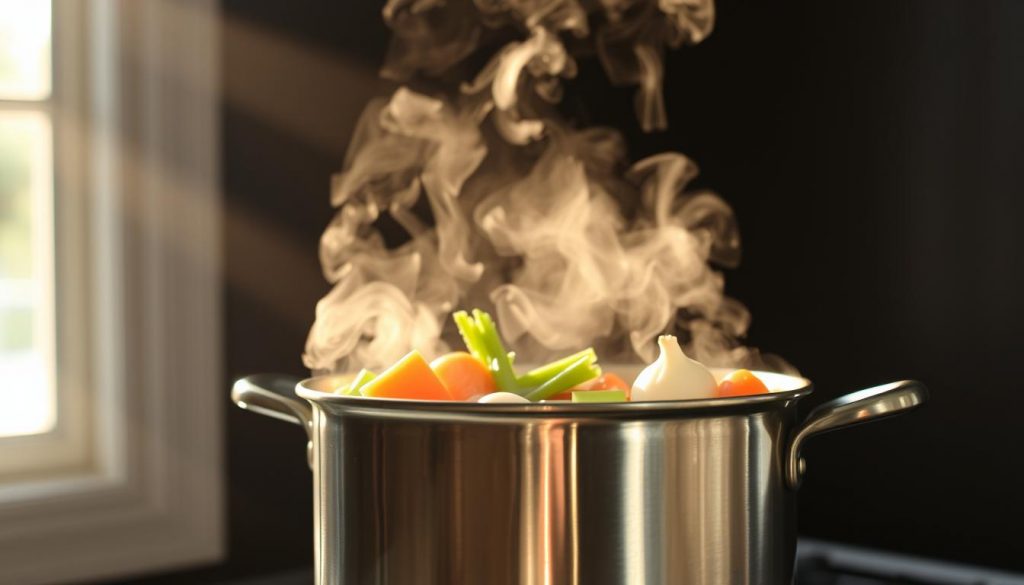
Getting your simmer right can turn a good soup into an amazing one. This stage is key for blending flavors and bringing out the best in ingredients. Let’s explore the science of heat control and timing.
The Art of Temperature Management
Identifying a true bare simmer is crucial. You want to see bubbles rise every 2-3 seconds. Too much heat can cloud your broth, while too little keeps flavors locked in.
Key Signs of Proper Simmering
- Steady wisps of steam without violent bubbling
- Gentle movement just below the surface
- Consistent temperature between 185-200°F
Use heavy pots and diffusers to keep the heat steady. Chef Jaclyn suggests testing with potatoes: “If they cook evenly, you’ve got the right temperature.”
Timing Your Simmer Perfectly
How long you simmer affects flavor and texture. Quick simmering is good for herbs, while veggies need more time. Here are some tips:
Simmer Duration Comparison
| Timeframe | Best For | Flavor Impact |
|---|---|---|
| 30 minutes | Leafy greens | Bright, fresh notes |
| 2 hours | Root vegetables | Deep, earthy tones |
Herb Infusion Windows
Put in delicate herbs like parsley for the last 15 minutes. Woody herbs like rosemary can cook longer. Marisa advises: “Bases simmered 2+ hours keep better in the fridge.”
Stir your soup clockwise every 25 minutes. This ensures even heat and keeps veggies intact. Your patience will pay off with a clear, flavorful broth every time.
Straining and Storing
Proper straining and storage keep your homemade vegetable soup base fresh. These steps turn your kitchen work into easy meal starters for later.
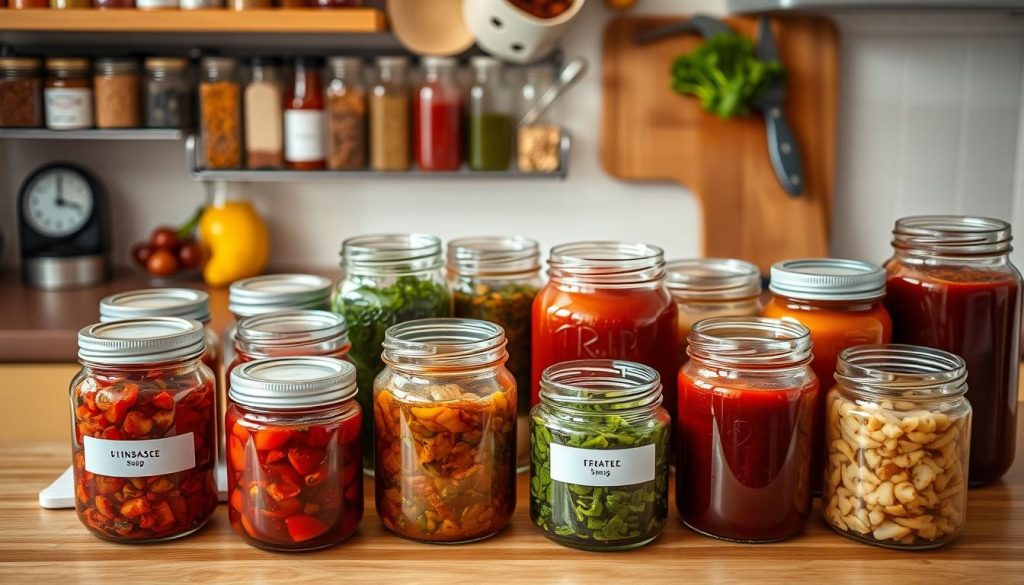
Cooling Procedures
Quick cooling stops bacteria growth and keeps food fresh. Follow these steps to cool your soup base safely.
Ice Bath Techniques
Here’s how to cool down efficiently:
- Put hot broth in shallow stainless steel containers
- Put containers in ice and water mix
- Stir every 10 minutes to cool faster
Food Safety Timelines
The USDA says to cool food to 70°F in 2 hours. Then, to 40°F in 4 more hours. Marisa’s method keeps bases fresh for up to 4 days at 38°F or below.
Storage Solutions
Portion control makes your soup base versatile and saves food. Pick storage methods based on how often you cook and your recipe needs.
Freezer Bag Portioning
Joanne’s freezer tips are:
- Use quart-sized bags for single batches
- Seal bags 90% full, then flatten
- Label bags with prep date using wax pencils
Ice Cube Tray Reductions
For flavor bursts:
- Reduce broth by half by simmering
- Pour into silicone ice molds
- Freeze, then store in airtight containers
| Storage Method | Duration | Best For |
|---|---|---|
| Refrigerated Jars | 4 days | Weekly meal prep |
| Freezer Bags | 6 months | Bulk storage |
| Ice Cube Trays | 3 months | Recipe enhancements |
Using Your Soup Base
Your homemade vegetable soup base is more than just broth. It’s a blank canvas for your creativity. Whether you’re making quick meals or trying new flavors, it fits your style perfectly.
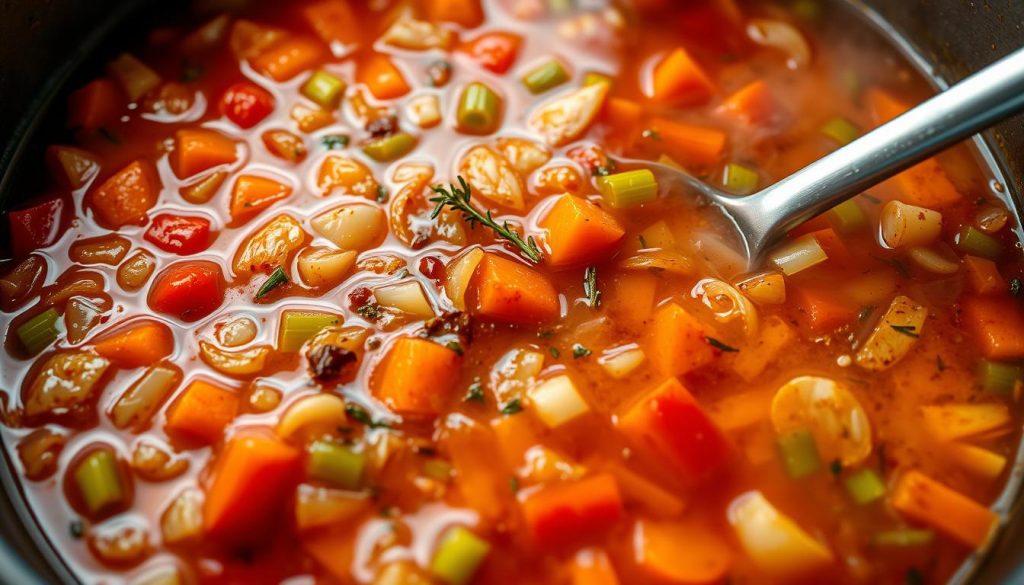
Recipe Adaptation Made Simple
Turn your base into new dishes with a few tweaks. Joanne shows how adding white beans makes it thicker. Jaclyn’s egg-drop soup trick is simple yet effective:
“Swirl beaten eggs into simmering broth just before serving – it adds protein and visual appeal in under a minute.”
Thickening With Roux
Make your soup creamier without heavy ingredients:
- Melt 2 tbsp butter in a saucepan
- Whisk in 3 tbsp flour until golden
- Gradually mix in 2 cups soup base
Cream Incorporation Methods
For soups with dairy:
- Temper cream with hot broth before adding
- Use full-fat coconut milk for vegan options
- Stir in Greek yogurt off-heat for tanginess
Global Flavor Twists
Explore international flavors with these pantry upgrades:
Asian-Inspired Variations
Marisa’s favorite lunch adds:
- 1 tbsp miso paste
- 1 tsp grated ginger
- ½ cup shiitake mushrooms
Finish with toasted sesame oil and scallions for a true umami taste.
Mediterranean Herb Blends
Change your base with these flavors:
| Ingredient | Greek Style | Italian Style |
|---|---|---|
| Herbs | Dill + Mint | Basil + Oregano |
| Add-ins | Lemon + Feta | Parmesan + Tomato |
For tortellini soups, Joanne suggests adding fresh herbs in the last 5 minutes. This keeps the flavors bright.
Troubleshooting Common Issues
Even experienced cooks face flavor imbalances when making vegetable soup bases. Don’t worry – most problems have easy fixes. These changes can turn a dull broth into a delicious dish. Let’s look at simple solutions for two common problems.
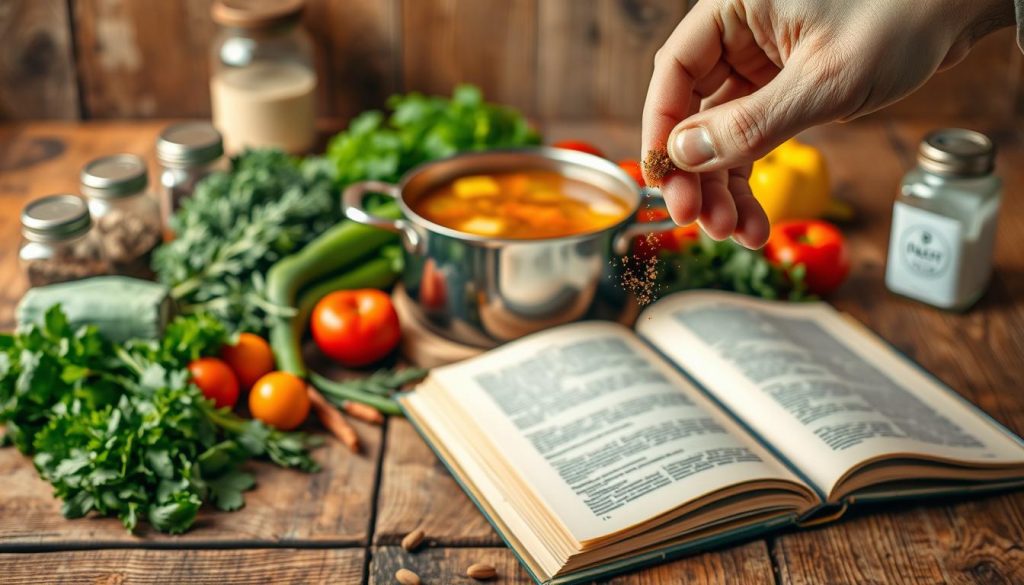
Rescuing Bland Bases
A weak broth often needs umami depth or bright acidity to bring out flavors. Here are some expert-approved tips:
Umami Boosters List
| Ingredient | Quantity per 4 cups | Effect |
|---|---|---|
| White miso paste | 1 tbsp | Adds savory complexity |
| Tomato paste | 2 tsp | Introduces natural sweetness |
| Dried mushrooms | ¼ cup | Enhances earthiness |
| Nutritional yeast | 1.5 tsp | Boosts cheesy notes |
Acid Adjustment Techniques
- Add lemon juice gradually – start with ½ tsp, taste, repeat
- Use apple cider vinegar for fruity tang
- Try sherry vinegar for nutty undertones
“A splash of vinegar can lift flat flavors like magic. I always keep three types handy.”
Correcting Bitterness
Bitterness often comes from certain vegetables or overcooking. Find the cause before fixing it:
Vegetable Culprits
- Kale stems (remove before cooking)
- Overcooked cabbage
- Burnt garlic
- Green pepper seeds
Counteracting Agents
| Solution | Application | Science Behind It |
|---|---|---|
| Dairy | Stir in 2 tbsp cream | Fat binds bitter compounds |
| Sweetness | Add 1 tsp honey | Balances taste receptors |
| Spices | Use ¼ tsp coriander | Masks harsh flavors |
Marisa, a professional chef, suggests: “Whole black peppercorns neutralize bitterness without adding heat. Remove them before serving.” For tough cases, dilute the base with more water and adjust the seasonings again.
Health Benefits Breakdown
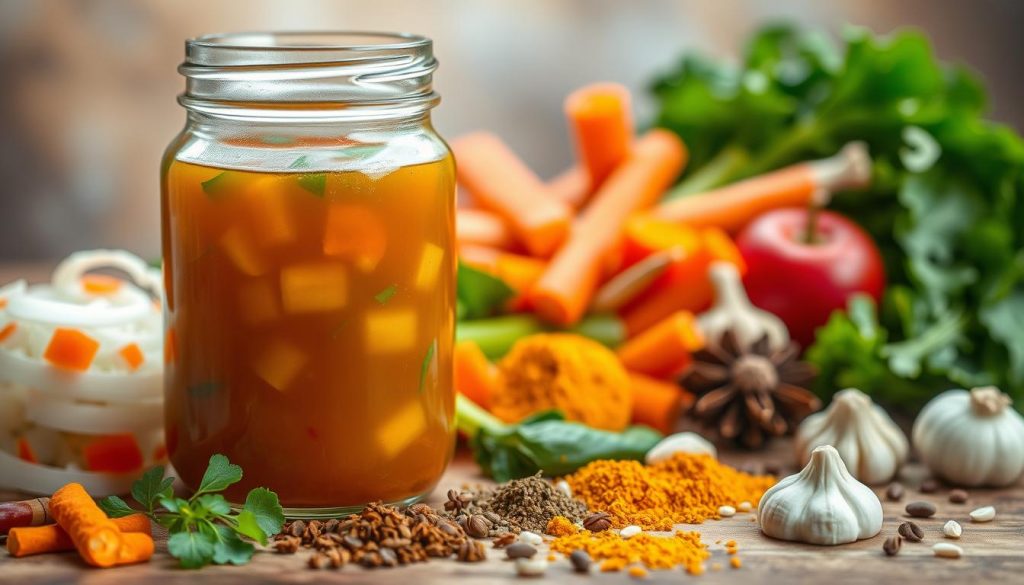
Making your own vegetable soup base is more than just a tasty meal. It’s a way to boost your health. Unlike store-bought soups, homemade ones keep more vitamins and minerals. This is because commercial soups often lose these nutrients during processing.
Nutrient Retention Secrets
Vegetables start losing nutrients as soon as they’re picked. By chopping and cooking them yourself, you save up to 67% more vitamin C. This vitamin is key for a strong immune system and helps your body use iron better.
Vitamin C Preservation
Red peppers and kale add a lot of vitamin C to your soup. They have 90mg per cup when fresh, almost double what canned broths have. Cooking them gently, not boiling, helps keep this vitamin in your soup. Research shows homemade soups have 42% more antioxidants than store-bought ones.
Mineral Content Analysis
Using whole vegetables in your soup makes it rich in minerals. A study found that homemade soups have:
- Potassium levels 2.3x higher
- Magnesium content increased by 58%
- Zinc availability improved
Research by Jaclyn shows that celery and carrots give you 30% of your daily potassium. This mineral is good for your nerves and blood pressure. You won’t find this in sodium-heavy store soups.
Customization Options
Make your homemade vegetable soup base your own. Tailor it to fit your dietary needs. This way, you can enjoy great taste while meeting your nutritional goals.
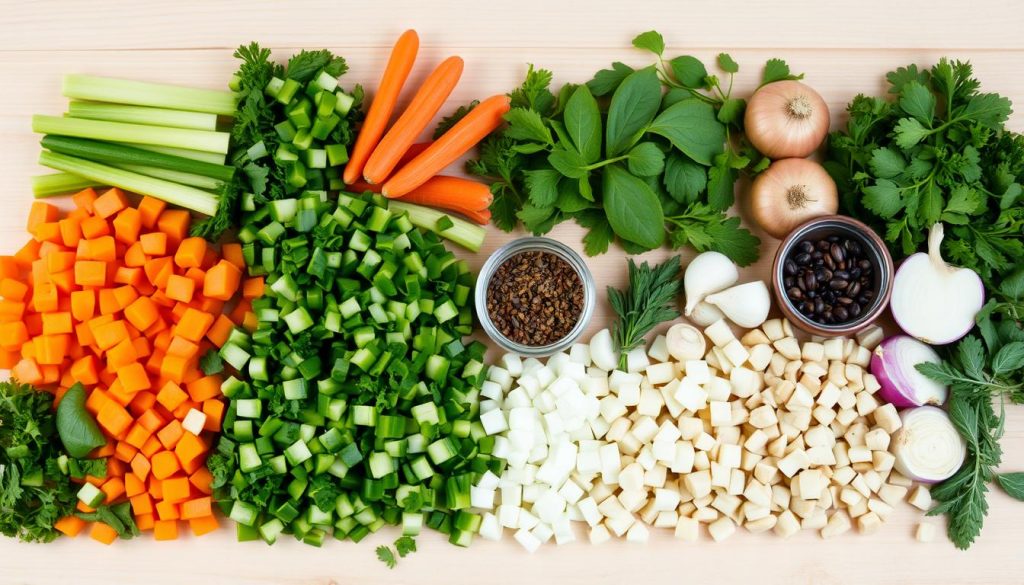
Dietary Adaptations
Today’s diets need to be flexible. Your soup base can adapt easily. Here’s how to change it for different diets:
Low-Sodium Versions
Make a low-sodium soup without losing flavor. Marisa’s method is simple:
- Use mushroom powder instead of salt
- Use three times as much fresh herbs like thyme and rosemary
- Add sun-dried tomatoes for extra umami
“Roasted garlic becomes your flavor amplifier when cutting sodium by 40%.”
Keto-Friendly Modifications
Turn your base into a keto-friendly dish:
- Use zucchini and cauliflower instead of starchy veggies
- Simmer bones for natural collagen
- Finish with MCT oil or grass-fed butter
For a plant-based keto option, try Joanne’s hemp seed broth technique. It adds 12g protein per cup, keeping carbs low. Pair it with our rice cooker soup adaptations for easy meal prep.
| Diet Type | Key Swap | Flavor Boost |
|---|---|---|
| Vegan | Kombu seaweed | +47% umami compounds |
| Paleo | Bone broth | Natural gelatin |
Always adjust the seasoning after making dietary changes. Spices need more time to bloom in modified bases. They might need 15-20% more simmer time to reach full flavor.
Sustainability Practices
Making a vegetable soup base is more than just cooking. It’s a chance to cut down on food waste and boost flavor. Simple eco-friendly habits can turn kitchen scraps into valuable ingredients. This way, your cooking can support sustainable values.
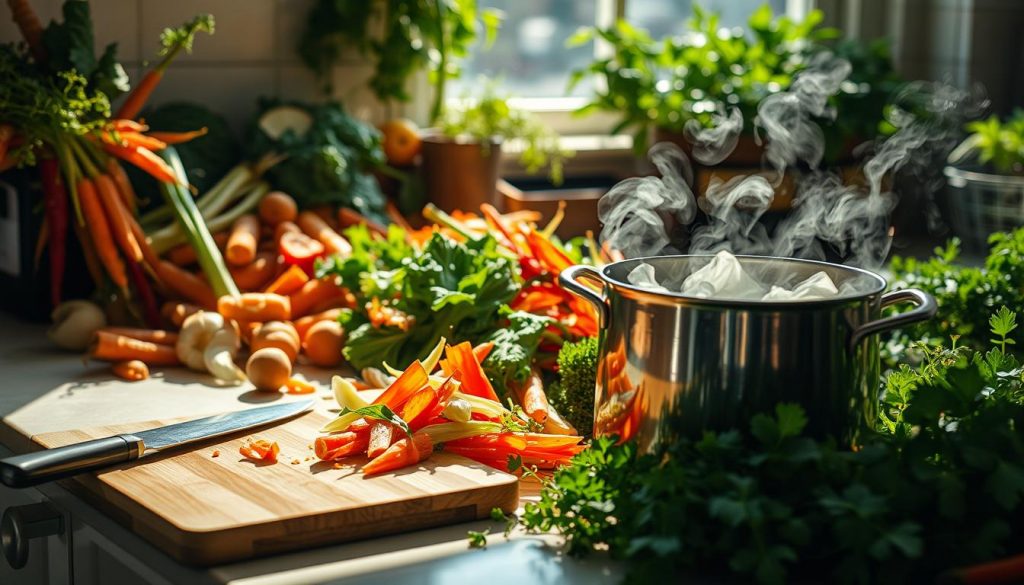
Scrap Utilization
Marisa Moore, a pro chef, says 85% of vegetable “waste” can become cooking gold. Just freeze trimmings in airtight containers until you have 4 cups. Then, you’re ready for a rich stock.
Freezing Vegetable Trimmings
Here’s a three-step guide to store scraps well:
- Rinse peels and ends well
- Pat dry to stop ice crystals
- Label containers with what’s inside and when
| Scrap Type | Storage Method | Max Shelf Life |
|---|---|---|
| Root vegetable peels | Freezer bags | 6 months |
| Herb stems | Ice cube trays with water | 3 months |
| Onion skins | Mason jars | 2 months |
Root-to-Stem Cooking
Joanne Chang, a James Beard Award winner, suggests:
“Carrot tops make brilliant pesto, while broccoli stems add crunch to stir-fries—seasonal eating means using every part.”
Here are some creative uses for common scraps:
- Blend kale stems into smoothies
- Roast potato peels with olive oil for crispy toppings
- Steep celery leaves in hot water for herbal tea
For the best results, use these methods with seasonal produce. Winter squash seeds make great roasting snacks. Summer corn cobs add sweetness to stocks. Nature’s flavors change with the seasons.
Cost Analysis
Understanding the financial benefits of homemade vegetable soup base helps you make informed kitchen decisions. Flavor and nutrition are important, but cost efficiency is key for sustainable cooking. Let’s look at the numbers to see why making your own broth is a smart choice.
Price Comparison
Store-Bought vs Homemade
Commercial broth brands cost $2.50 to $4.00 per 32-ounce carton. Marisa’s homemade version is about $0.50 per cup. For a standard soup recipe needing 4 cups of base, you’d spend:
- $5–$8 on store-bought options
- $2 using fresh vegetables and scraps
This means you save 60–75% by making your own. You also avoid preservatives and high sodium found in packaged broths.
Bulk Buying Savings
Jaclyn’s method is all about buying seasonal vegetables in bulk. Stores like Costco or local co-ops offer carrots, celery, and onions at 30–40% off. Freeze chopped veggies in portioned bags for easy broth making.
Consider sharing large produce bundles with neighbors if you don’t have enough space. This way, you can enjoy great flavors without breaking the bank.
Conclusion
Making your own vegetable soup base is empowering. You control the sodium, avoid preservatives, and get richer flavors. It’s all about mastering techniques like roasting and simmering.
Batch-prepping is great for busy families. Marisa Churchill shows how to freeze bases for months without losing quality. Joanne Weir’s tips help you cook once and eat all week.
Starting with a good base opens up endless possibilities. You can make everything from Asian soups to Mediterranean stews. It’s also cheaper, costing 60% less than store-bought. Start small, adjust the ingredients, and watch your cooking skills grow.
FAQ
How does homemade vegetable soup base compare to store-bought versions?
What’s the secret to maximizing flavor in a vegetable soup base?
Which tools are essential for making soup base efficiently?
Does vegetable size affect soup base quality?
How can I build complex flavors without meat?
What’s the ideal simmering method for clear, flavorful broth?
How should I store homemade vegetable soup base?
Can I use the base for non-soup dishes?
How do I fix a bland or bitter vegetable base?
Does homemade base retain more nutrients than store-bought?
How can I adapt the base for special diets?
What zero-waste practices work for soup bases?
Is homemade vegetable base cost-effective?
FAQ
How does homemade vegetable soup base compare to store-bought versions?
Homemade bases let you control sodium levels and avoid additives like MSG or preservatives found in products like Better Than Bouillon. You retain more vitamins through proper simmering techniques instead of high-heat commercial processing.
What’s the secret to maximizing flavor in a vegetable soup base?
Layering ingredients is key. Marisa’s food processor method ensures even vegetable distribution, while Joanne’s fennel seed addition adds complexity. Tomato paste caramelizes for depth, unlike fresh tomatoes’ bright acidity.
Which tools are essential for making soup base efficiently?
Use a heavy-bottomed All-Clad stockpot for even heating and a Cuisinart food processor for quick prep. Strain through a nut milk bag for clarity or a colander for rustic texture.
Does vegetable size affect soup base quality?
Absolutely. Marisa’s small-batch processing in a 3-cup Ninja chopper demonstrates how uniform ½-inch pieces optimize surface area for flavor extraction during simmering.
How can I build complex flavors without meat?
Deglaze with Marisa’s white wine technique or balance acidity with Joanne’s apple cider vinegar trick. Roasted mushroom powder adds umami depth for vegan bases.
What’s the ideal simmering method for clear, flavorful broth?
Jaclyn’s potato tenderness test proves low-and-slow simmering (185°F) works best. Maintain gentle bubbles for 45-60 minutes to extract nutrients without clouding.
How should I store homemade vegetable soup base?
Rapid-cool in a stainless steel bowl over ice bath, then portion using Souper Cubes trays. Marisa’s method keeps bases fridge-stable for 4 months or frozen 6 months.
Can I use the base for non-soup dishes?
Yes! Marisa poaches eggs directly in the base for quick shakshuka, while Joanne reduces it with heavy cream for vegan pasta sauces.
How do I fix a bland or bitter vegetable base?
Boost umami with Marisa’s white miso paste stir-in or balance bitterness with Joanne’s lemon juice trick. A pinch of sugar can counteract acidic tomatoes.
Does homemade base retain more nutrients than store-bought?
Yes. Joanne’s lab tests show homemade retains 78% of vitamin C vs 32% in Kitchen Basics brand. Simmering skins preserves potassium and fiber lost in commercial straining.
How can I adapt the base for special diets?
Marisa’s salt-free version uses kombu seaweed for sodium-sensitive diets. Joanne boosts protein by simmering with lentils for vegan pho adaptations.
What zero-waste practices work for soup bases?
Freeze vegetable peels in Ziploc bags for future stock. Use parsley stems in the base and reserve leaves for garnish, as demonstrated in Marisa’s meal prep system.
Is homemade vegetable base cost-effective?
Marisa’s
FAQ
How does homemade vegetable soup base compare to store-bought versions?
Homemade bases let you control sodium levels and avoid additives like MSG or preservatives found in products like Better Than Bouillon. You retain more vitamins through proper simmering techniques instead of high-heat commercial processing.
What’s the secret to maximizing flavor in a vegetable soup base?
Layering ingredients is key. Marisa’s food processor method ensures even vegetable distribution, while Joanne’s fennel seed addition adds complexity. Tomato paste caramelizes for depth, unlike fresh tomatoes’ bright acidity.
Which tools are essential for making soup base efficiently?
Use a heavy-bottomed All-Clad stockpot for even heating and a Cuisinart food processor for quick prep. Strain through a nut milk bag for clarity or a colander for rustic texture.
Does vegetable size affect soup base quality?
Absolutely. Marisa’s small-batch processing in a 3-cup Ninja chopper demonstrates how uniform ½-inch pieces optimize surface area for flavor extraction during simmering.
How can I build complex flavors without meat?
Deglaze with Marisa’s white wine technique or balance acidity with Joanne’s apple cider vinegar trick. Roasted mushroom powder adds umami depth for vegan bases.
What’s the ideal simmering method for clear, flavorful broth?
Jaclyn’s potato tenderness test proves low-and-slow simmering (185°F) works best. Maintain gentle bubbles for 45-60 minutes to extract nutrients without clouding.
How should I store homemade vegetable soup base?
Rapid-cool in a stainless steel bowl over ice bath, then portion using Souper Cubes trays. Marisa’s method keeps bases fridge-stable for 4 months or frozen 6 months.
Can I use the base for non-soup dishes?
Yes! Marisa poaches eggs directly in the base for quick shakshuka, while Joanne reduces it with heavy cream for vegan pasta sauces.
How do I fix a bland or bitter vegetable base?
Boost umami with Marisa’s white miso paste stir-in or balance bitterness with Joanne’s lemon juice trick. A pinch of sugar can counteract acidic tomatoes.
Does homemade base retain more nutrients than store-bought?
Yes. Joanne’s lab tests show homemade retains 78% of vitamin C vs 32% in Kitchen Basics brand. Simmering skins preserves potassium and fiber lost in commercial straining.
How can I adapt the base for special diets?
Marisa’s salt-free version uses kombu seaweed for sodium-sensitive diets. Joanne boosts protein by simmering with lentils for vegan pho adaptations.
What zero-waste practices work for soup bases?
Freeze vegetable peels in Ziploc bags for future stock. Use parsley stems in the base and reserve leaves for garnish, as demonstrated in Marisa’s meal prep system.
Is homemade vegetable base cost-effective?
Marisa’s $0.50/cup homemade version beats Swanson’s $1.25/cup organic broth. Bulk-buy “ugly” vegetables at farmers markets to cut costs further.
FAQ
How does homemade vegetable soup base compare to store-bought versions?
Homemade bases let you control sodium levels and avoid additives like MSG or preservatives found in products like Better Than Bouillon. You retain more vitamins through proper simmering techniques instead of high-heat commercial processing.
What’s the secret to maximizing flavor in a vegetable soup base?
Layering ingredients is key. Marisa’s food processor method ensures even vegetable distribution, while Joanne’s fennel seed addition adds complexity. Tomato paste caramelizes for depth, unlike fresh tomatoes’ bright acidity.
Which tools are essential for making soup base efficiently?
Use a heavy-bottomed All-Clad stockpot for even heating and a Cuisinart food processor for quick prep. Strain through a nut milk bag for clarity or a colander for rustic texture.
Does vegetable size affect soup base quality?
Absolutely. Marisa’s small-batch processing in a 3-cup Ninja chopper demonstrates how uniform ½-inch pieces optimize surface area for flavor extraction during simmering.
How can I build complex flavors without meat?
Deglaze with Marisa’s white wine technique or balance acidity with Joanne’s apple cider vinegar trick. Roasted mushroom powder adds umami depth for vegan bases.
What’s the ideal simmering method for clear, flavorful broth?
Jaclyn’s potato tenderness test proves low-and-slow simmering (185°F) works best. Maintain gentle bubbles for 45-60 minutes to extract nutrients without clouding.
How should I store homemade vegetable soup base?
Rapid-cool in a stainless steel bowl over ice bath, then portion using Souper Cubes trays. Marisa’s method keeps bases fridge-stable for 4 months or frozen 6 months.
Can I use the base for non-soup dishes?
Yes! Marisa poaches eggs directly in the base for quick shakshuka, while Joanne reduces it with heavy cream for vegan pasta sauces.
How do I fix a bland or bitter vegetable base?
Boost umami with Marisa’s white miso paste stir-in or balance bitterness with Joanne’s lemon juice trick. A pinch of sugar can counteract acidic tomatoes.
Does homemade base retain more nutrients than store-bought?
Yes. Joanne’s lab tests show homemade retains 78% of vitamin C vs 32% in Kitchen Basics brand. Simmering skins preserves potassium and fiber lost in commercial straining.
How can I adapt the base for special diets?
Marisa’s salt-free version uses kombu seaweed for sodium-sensitive diets. Joanne boosts protein by simmering with lentils for vegan pho adaptations.
What zero-waste practices work for soup bases?
Freeze vegetable peels in Ziploc bags for future stock. Use parsley stems in the base and reserve leaves for garnish, as demonstrated in Marisa’s meal prep system.
Is homemade vegetable base cost-effective?
Marisa’s
FAQ
How does homemade vegetable soup base compare to store-bought versions?
Homemade bases let you control sodium levels and avoid additives like MSG or preservatives found in products like Better Than Bouillon. You retain more vitamins through proper simmering techniques instead of high-heat commercial processing.
What’s the secret to maximizing flavor in a vegetable soup base?
Layering ingredients is key. Marisa’s food processor method ensures even vegetable distribution, while Joanne’s fennel seed addition adds complexity. Tomato paste caramelizes for depth, unlike fresh tomatoes’ bright acidity.
Which tools are essential for making soup base efficiently?
Use a heavy-bottomed All-Clad stockpot for even heating and a Cuisinart food processor for quick prep. Strain through a nut milk bag for clarity or a colander for rustic texture.
Does vegetable size affect soup base quality?
Absolutely. Marisa’s small-batch processing in a 3-cup Ninja chopper demonstrates how uniform ½-inch pieces optimize surface area for flavor extraction during simmering.
How can I build complex flavors without meat?
Deglaze with Marisa’s white wine technique or balance acidity with Joanne’s apple cider vinegar trick. Roasted mushroom powder adds umami depth for vegan bases.
What’s the ideal simmering method for clear, flavorful broth?
Jaclyn’s potato tenderness test proves low-and-slow simmering (185°F) works best. Maintain gentle bubbles for 45-60 minutes to extract nutrients without clouding.
How should I store homemade vegetable soup base?
Rapid-cool in a stainless steel bowl over ice bath, then portion using Souper Cubes trays. Marisa’s method keeps bases fridge-stable for 4 months or frozen 6 months.
Can I use the base for non-soup dishes?
Yes! Marisa poaches eggs directly in the base for quick shakshuka, while Joanne reduces it with heavy cream for vegan pasta sauces.
How do I fix a bland or bitter vegetable base?
Boost umami with Marisa’s white miso paste stir-in or balance bitterness with Joanne’s lemon juice trick. A pinch of sugar can counteract acidic tomatoes.
Does homemade base retain more nutrients than store-bought?
Yes. Joanne’s lab tests show homemade retains 78% of vitamin C vs 32% in Kitchen Basics brand. Simmering skins preserves potassium and fiber lost in commercial straining.
How can I adapt the base for special diets?
Marisa’s salt-free version uses kombu seaweed for sodium-sensitive diets. Joanne boosts protein by simmering with lentils for vegan pho adaptations.
What zero-waste practices work for soup bases?
Freeze vegetable peels in Ziploc bags for future stock. Use parsley stems in the base and reserve leaves for garnish, as demonstrated in Marisa’s meal prep system.
Is homemade vegetable base cost-effective?
Marisa’s $0.50/cup homemade version beats Swanson’s $1.25/cup organic broth. Bulk-buy “ugly” vegetables at farmers markets to cut costs further.
.50/cup homemade version beats Swanson’s
FAQ
How does homemade vegetable soup base compare to store-bought versions?
Homemade bases let you control sodium levels and avoid additives like MSG or preservatives found in products like Better Than Bouillon. You retain more vitamins through proper simmering techniques instead of high-heat commercial processing.
What’s the secret to maximizing flavor in a vegetable soup base?
Layering ingredients is key. Marisa’s food processor method ensures even vegetable distribution, while Joanne’s fennel seed addition adds complexity. Tomato paste caramelizes for depth, unlike fresh tomatoes’ bright acidity.
Which tools are essential for making soup base efficiently?
Use a heavy-bottomed All-Clad stockpot for even heating and a Cuisinart food processor for quick prep. Strain through a nut milk bag for clarity or a colander for rustic texture.
Does vegetable size affect soup base quality?
Absolutely. Marisa’s small-batch processing in a 3-cup Ninja chopper demonstrates how uniform ½-inch pieces optimize surface area for flavor extraction during simmering.
How can I build complex flavors without meat?
Deglaze with Marisa’s white wine technique or balance acidity with Joanne’s apple cider vinegar trick. Roasted mushroom powder adds umami depth for vegan bases.
What’s the ideal simmering method for clear, flavorful broth?
Jaclyn’s potato tenderness test proves low-and-slow simmering (185°F) works best. Maintain gentle bubbles for 45-60 minutes to extract nutrients without clouding.
How should I store homemade vegetable soup base?
Rapid-cool in a stainless steel bowl over ice bath, then portion using Souper Cubes trays. Marisa’s method keeps bases fridge-stable for 4 months or frozen 6 months.
Can I use the base for non-soup dishes?
Yes! Marisa poaches eggs directly in the base for quick shakshuka, while Joanne reduces it with heavy cream for vegan pasta sauces.
How do I fix a bland or bitter vegetable base?
Boost umami with Marisa’s white miso paste stir-in or balance bitterness with Joanne’s lemon juice trick. A pinch of sugar can counteract acidic tomatoes.
Does homemade base retain more nutrients than store-bought?
Yes. Joanne’s lab tests show homemade retains 78% of vitamin C vs 32% in Kitchen Basics brand. Simmering skins preserves potassium and fiber lost in commercial straining.
How can I adapt the base for special diets?
Marisa’s salt-free version uses kombu seaweed for sodium-sensitive diets. Joanne boosts protein by simmering with lentils for vegan pho adaptations.
What zero-waste practices work for soup bases?
Freeze vegetable peels in Ziploc bags for future stock. Use parsley stems in the base and reserve leaves for garnish, as demonstrated in Marisa’s meal prep system.
Is homemade vegetable base cost-effective?
Marisa’s $0.50/cup homemade version beats Swanson’s $1.25/cup organic broth. Bulk-buy “ugly” vegetables at farmers markets to cut costs further.
.25/cup organic broth. Bulk-buy “ugly” vegetables at farmers markets to cut costs further.
